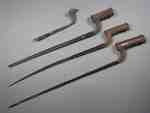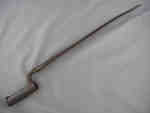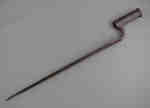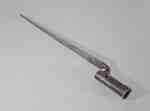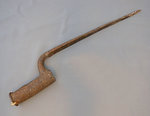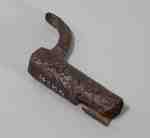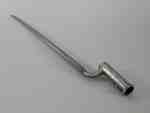Results
- A metal bayonet sheath, measuring 23 ¼ x 1 1/2 . This item can currently be found at the Willoughby Museum.A metal bayonet sheath, measuring 23 ¼ x 1 1/2 . This …
- This item can currently be found at the Willoughby Museum.This item can currently be found at the Willoughby Museum.
- These are a few examples of steel bayonets from the War of 1812-1814. The largest bayonet’s base (most likely British) measures 10cm long, 2.5cm in diameter and the blade is 41.5cm long and 2.5 cm wiThese are a few examples of steel bayonets from the War of …
- This bayonet is of an officer’s fusil musket design. It has a triangular blade and is date circa 1812. A bayonet is a steel blade that is designed to fit on the muzzle of a rifle or musket barrel, maThis bayonet is of an officer’s fusil musket design. It has a …
- This is a bayonet that would have been designed to fit on the muzzle of a Brown Bess musket. There is an inscription on the base of the stock that looks to be an underlined “A” with “33” below.This is a bayonet that would have been designed to fit on …
- A homemade bayonet that was designed to fit on the muzzle of a rifle or musket. It is of the styling favored most by the militia units during the War of 1812. Its unique length and lack of a rear reiA homemade bayonet that was designed to fit on the muzzle of …
- This is a bayonet that would have been designed to fit on the muzzle of a rifle or musket. Unique markings include a crown with the inscriptions “40”, “WHEELER”, “O”, and a “V” on the front of the blThis is a bayonet that would have been designed to fit on …
- This bayonet would have been designed to fit on the muzzle of a Brown Bess musket. It is slightly bent at the tip and unique markings on the blade include: a crown with “31”, “I. Salter” and what looThis bayonet would have been designed to fit on the muzzle of …
- This is a black leather bayonet sheath that measures 37.5cm in length. There is also a frog clip that was used to mount it on a belt. Stamped into the sheath near the frog clip are the markings: “E”,This is a black leather bayonet sheath that measures 37.5cm in length. …
- This is a remnant of the tip of a bayonet sheath which can be found at the Battleground Hotel Museum.This is a remnant of the tip of a bayonet sheath which …
- This triangular bladed bayonet was designed to fit on the muzzle of a rifle or musket barrel, making it into a close range weapon. This would have been on arguably every soldier’s firearm during theThis triangular bladed bayonet was designed to fit on the muzzle of …
- This bayonet, with a broken tip, would have been designed to fit on the muzzle of a rifle or musket barrel, making it into a close range weapon. There are markings on the bayonet which include: “HarvThis bayonet, with a broken tip, would have been designed to fit …
- This steel bayonet would have been designed to fit on the muzzle of a rifle or musket barrel, making it into a close range weapon. There are no visible identifying marks but it is the proper size andThis steel bayonet would have been designed to fit on the muzzle …
- This bayonet would have been designed to fit on the muzzle of a rifle or musket barrel, making it into a close range weapon. There is a marking on the blade that has a triangular-like symbol with a “This bayonet would have been designed to fit on the muzzle of …
- This original Brown Bess socket mount bayonet is vintage War of 1812. It was purchased in the Niagara area and likely has a long local provenance.This original Brown Bess socket mount bayonet is vintage War of 1812. …
- This is a bayonet socket with a small portion of the blade attached that was discovered in the Niagara River. A bayonet is a steel blade that is designed to fit on the muzzle of a rifle or musket barThis is a bayonet socket with a small portion of the blade …
- This bayonet, dated 1812-1814, has triangular blade. It was recovered from the Niagara River in 1980.This bayonet, dated 1812-1814, has triangular blade. It was recovered from the …
- This triangular bayonet is dated circa 1812 and has the distinctive markings “S. Chambers” and “46 (Crown)” on the blade. A bayonet was designed to fit on the muzzle of a rifle or musket barrel, makiThis triangular bayonet is dated circa 1812 and has the distinctive markings …
- This bayonet would have been designed to fit on the muzzle of a rifle or musket barrel, making it into a close range weapon. There is an inscription near the socket that reads “US, F.B.” A bayonet woThis bayonet would have been designed to fit on the muzzle of …
- This is a portion of a bayonet that would have been designed to fit on the muzzle of a rifle or musket barrel, making it into a close range weapon. The socket is complete and the blade has been bent.This is a portion of a bayonet that would have been designed …
When selecting an individual record or object, you will move
to the website of the heritage institution that houses the item.
To return to the search or results pages, select "Back", "Results" or "New Search".
 This project was made possible with the support of the Department of Canadian Heritage
This project was made possible with the support of the Department of Canadian Heritage
through the Canadian Culture Online Strategy.
to the website of the heritage institution that houses the item.
To return to the search or results pages, select "Back", "Results" or "New Search".
 This project was made possible with the support of the Department of Canadian Heritage
This project was made possible with the support of the Department of Canadian Heritage through the Canadian Culture Online Strategy.









